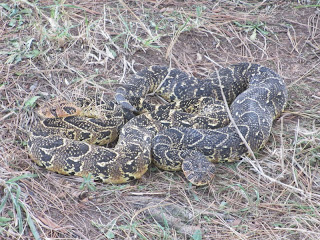It shouldn't still be as hot as this? 32 degrees?
Well the Darter thought so!
Meanwhile, these two Puff Adders decided the weather was right for an amorous embrace!
On our way back, they were copulating; it's said they hatch up to 80 young!
We know where to find this Erica multumbellifera or Many Umbrellas Heath. What wasn't obvious were the holes in the sides of many of the flowers! Could it be, because the mouth of the flower is so small, that certain insects have to make a hole in the side to get to the pollen and nectar?
It's taking a long time, but gradually the Ericas are turning brown, flower by flower:
But just as we thought they were all over, we found one in bud! It looks as though the flowers will be white. We'll check!
This impressive Erica is growing in a circle, like a doughnut!
This tall Erica looks impressive now:
The Stoebe spiralis are covered with spent flowers, so the pale yellow splashes are now brown. But the new shoots are growing past the old flowers:
Likewise the Stoebe plumosa, or Seriphium plumosum, aka Slangbos:
I notice that the Liparia splendens ssp splendens, Mountain Dahlia or Orange Nodding Head is listed with SANBI as 'vulnerable'. We know of about eight plants in our small 'patch', Good News!
There are not so many flowers on this one, but it has recently been exposed to the sun by the regrowth pines being cut down. The flowers are distinctive:
This is a new one to us, the flower looks like an Oxalis, but the stem is long and the leaves are round. This one is growing up in another plant.
Pippa's sharp eyes spotted this which we think is Bulbinella trinervis:
The flower up close:
Close by were some spent flowers on another plant:
Chewing on a plucked leaf confirmed my guess: Tulbaghia, or wild garlic! We were in this area only a few weeks ago, the flowers must have come and gone quite quickly, otherwise we would have noticed them!
A Metalasia, with the same spiky leaves that I noticed at the other end of the valley a couple of weeks ago:
Impressive Restios:
We're noticing more and more Brabejum stellatifolium or Wild Almond. It's worrying that there's a vague similarity to Acacia longifolia, at least from a distance. We hope some over-zealous person with a back-pack sprayer doesn't confuse them!
We'll be watching the development of the flowers as they turn to fruit:
One last Tritoniopsis?
Here's a shrub we need to find a name for, we're noticing more of them:
Closer-up, the older leaves turn a distinctive orange:
And this one, between two Bunias:
It's in flower now, the buds are slightly pink and the leaves serrated. Notice the ants on the stem!
It was still hot when we were on the way home!
On a farm in the week, I spotted this Honeysuckle:
I'll be in the Eastern Freestate next weekend, I wonder what I'll find......... :-) A
| ||
Sunday, 13 April 2014
Indian Summer Flower Walk
Labels:
Brajejum,
Bulbinella,
Erica,
Liparia,
Metalasia,
new,
Oxalis,
Restio,
Stoebe,
Tecoma,
Tritoniopsis
Location:
Grabouw, South Africa
Subscribe to:
Post Comments (Atom)





























No comments:
Post a Comment